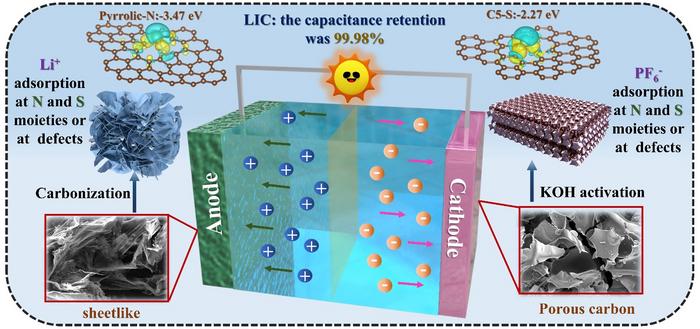| Jul 26, 2023 |
Advancing heteroatom-doped porous carbon nanomaterials for lithium-based energy storage applications
(Nanowerk News) The portable and electric energy storage market has long been dominated by lithium-ion batteries (LIBs) and supercapacitors, surpassing other energy storage systems in their ability to provide higher energy and power. However, in critical applications such as electric vehicles, there is a growing demand for a device that can efficiently produce both high power and high energy over a significant number of cycles. Meeting these rigorous standards presents new challenges for existing technologies, prompting researchers to explore alternative technologies for energy storage devices.
|
|
A promising strategy is to modify the high-conductive hard carbon anode, which exhibits excellent structural stability, to match it with an activated carbon cathode, thus creating a dual-carbon LIC (lithium-ion capacitor). In this study, a one-pot in-situ expansion and heteroatom doping strategy was employed to prepare sheet-like hard carbon, while the activated carbon was obtained through activation processes.
|
|
“However, ion kinetics mismatch between cathode and anode can lead to unsatisfied cycling lifetime and anode degradation,” explained Yingxiong Wang, corresponding of a new study that addressed this limitation. “We used a special method to create two types of carbon materials: sheet-like hard carbon and activated carbon.”
|
 |
| A strategy for the commercial large-scale production of heteroatom-doped porous carbon materials. (Image: KeAi Communications)
|
|
Wang and his co-workers used ammonium persulfate to help expand and modify the hard carbon, making it better for use in batteries. The carbon materials, known as FRNS-HC and FRNS-AC, were made from furfural residues, which are leftovers from a natural substance. They were then tested in LIBs.
|
|
“The results were impressive—when FRNS-HC was used as the negative part of the battery, it could store 374 mAh g-1 at low power level, and 123.1 mAh g-1 at a higher power level,” shared Wang. “When combined with a special porous carbon material as the positive part of the battery, the whole battery showed a high specific energy of 147.67 Wh kg-1, with a power output of about 199.93 W kg-1.”
|
|
Notably, the battery also lasted a very long time, with almost no loss in performance even after being charged and discharged 1,000 times. The team published their findings in the journal Green Energy & Environment ("Furfural residues derived nitrogen-sulfur co-doped sheet-like carbon: An excellent electrode for dual carbon lithium-ion capacitors").
|
|
"We recommend the use of biomass-based raw materials as carbon precursors, along with efficient and eco-friendly synthesis techniques," said Wang. "This study offers a promising approach to create heteroatom-doped porous carbon from biomass waste, and it holds great potential for advancing high-energy-density devices."
|

